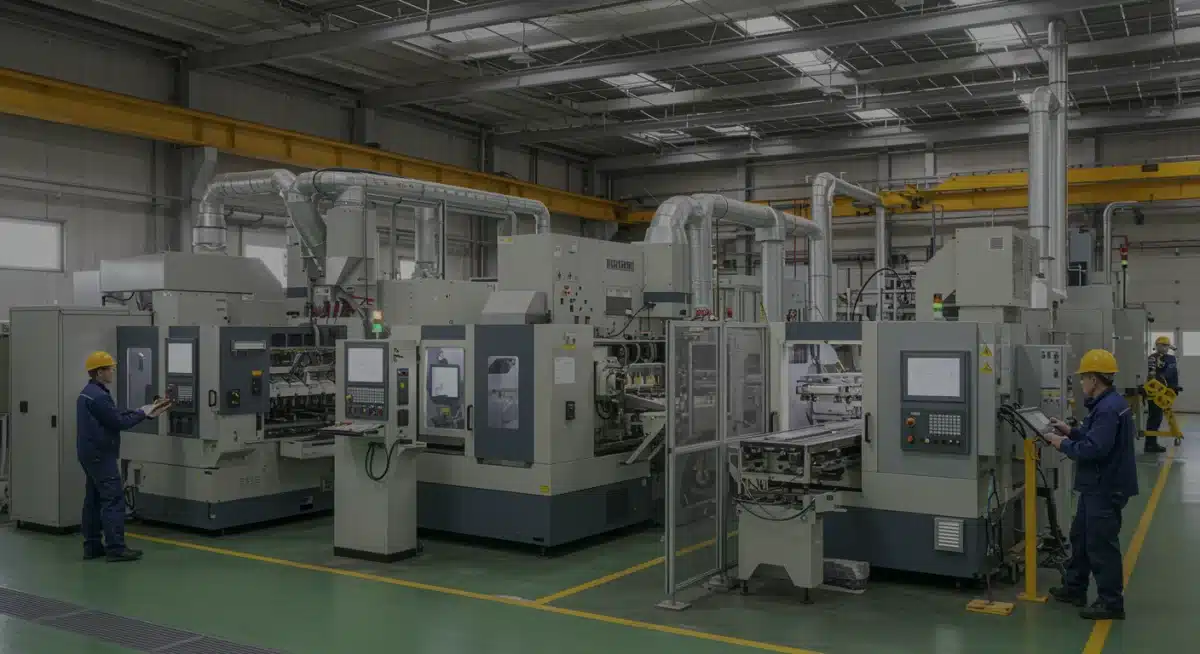2025 Shift to Sustainable Business: U.S. Firms Gain Advantage

The 2025 shift to sustainable business practices is emerging as a critical competitive advantage for U.S. firms, driven by evolving consumer expectations, investor demands, and a dynamic regulatory landscape.
As 2025 rapidly approaches, the landscape for American enterprises is undergoing a profound transformation. The focus on sustainable business advantage is no longer a niche concern but a mainstream imperative, with U.S. firms increasingly recognizing its role in securing a competitive edge. This shift isn’t just about environmental stewardship; it’s a strategic move impacting financial performance, brand reputation, and long-term viability.
The Accelerating Pace of Sustainable Transformation
The transition toward sustainable business practices is accelerating across various sectors within the U.S. economy. Businesses are finding that early adoption of these principles not only mitigates risks but also unlocks new opportunities for innovation and market leadership. This trend is driven by a confluence of factors, including evolving consumer values, stricter regulatory frameworks, and the increasing influence of ESG (Environmental, Social, and Governance) investing.
Companies that have proactively integrated sustainability into their core operations are already reporting tangible benefits. These benefits range from reduced operational costs through energy efficiency to enhanced brand loyalty among environmentally conscious consumers. The competitive landscape is being redefined, with sustainability becoming a key differentiator rather than merely a compliance issue.
Consumer Demand as a Catalyst for Change
A significant driver for the shift towards sustainability is the growing demand from consumers for eco-friendly products and services. Recent surveys indicate a strong preference for brands that demonstrate clear commitments to environmental and social responsibility. This consumer pressure is compelling U.S. firms to re-evaluate their supply chains, manufacturing processes, and overall environmental footprint.
- Increased willingness to pay more for sustainable products.
- Preference for brands with transparent sustainability reporting.
- Expectation for companies to address climate change and social issues.
Regulatory Landscape and Policy Incentives
Government policies and regulations are playing an increasingly pivotal role in shaping the sustainable business environment for U.S. firms. As 2025 approaches, federal and state initiatives are providing both mandates and incentives for companies to adopt greener practices. These policies aim to reduce carbon emissions, promote renewable energy, and encourage responsible resource management, creating a more level playing field while fostering innovation.
Recent legislative developments, including infrastructure investments and tax credits for green technologies, are making it more economically attractive for businesses to invest in sustainability. Companies that align with these regulatory shifts can gain a significant competitive advantage by accessing new funding opportunities and avoiding potential penalties for non-compliance. This proactive engagement is becoming a hallmark of leading firms.
Key Regulatory Drivers
Several key regulatory drivers are pushing U.S. firms towards greater sustainability. These include evolving reporting requirements, carbon pricing discussions, and incentives for renewable energy adoption. The aim is to create a robust framework that supports long-term environmental and economic health.
- Enhanced corporate sustainability reporting mandates.
- Federal and state tax credits for renewable energy projects.
- Increased scrutiny on supply chain due diligence and emissions.
Investor Relations and ESG Integration
The financial community’s focus on ESG factors has dramatically reshaped how investors evaluate and allocate capital. For U.S. firms, demonstrating strong ESG performance is no longer optional; it’s a prerequisite for attracting and retaining investment. Institutional investors, mutual funds, and even individual shareholders are increasingly prioritizing companies with robust sustainability strategies, viewing them as better positioned for long-term value creation.
Companies that effectively integrate ESG principles into their business models are often seen as less risky and more resilient to future environmental and social challenges. This focus translates into lower capital costs, increased access to green financing, and a more favorable valuation in the market. The competitive advantage here is clear: strong ESG performance directly impacts a firm’s financial health and investor appeal.

Technological Innovations Driving Green Solutions
Technological advancements are at the forefront of enabling U.S. firms to achieve their sustainability goals. Innovations in renewable energy, waste reduction, and circular economy models are providing practical and scalable solutions for businesses across industries. From AI-powered energy management systems to advanced materials science for sustainable packaging, technology is a key enabler of green transformation.
Investing in these cutting-edge technologies not only helps companies reduce their environmental impact but also often leads to significant operational efficiencies and cost savings. Firms that embrace and integrate these innovations are better equipped to optimize resource use, minimize waste, and develop new, environmentally friendly products and services, further solidifying their sustainable business advantage.
Emerging Green Technologies
The pace of innovation in green technology is rapid, offering a wealth of tools and solutions for businesses committed to sustainability. These technologies are making it easier and more cost-effective to implement sustainable practices.
- Artificial intelligence for optimizing energy consumption.
- Advanced recycling and waste-to-energy conversion systems.
- Sustainable agriculture technologies and precision farming.
Supply Chain Resilience Through Sustainable Practices
The global supply chain has faced unprecedented disruptions in recent years, highlighting the critical need for resilience. U.S. firms are increasingly recognizing that sustainable supply chain practices are not just good for the environment but are essential for building robust and adaptable operations. By focusing on ethical sourcing, reducing waste, and improving logistics efficiency, companies can mitigate risks and enhance their overall supply chain stability.
Sustainable supply chains often involve greater transparency and collaboration with suppliers, leading to stronger relationships and better risk management. This approach can help firms avoid disruptions caused by environmental disasters, social unrest, or resource scarcity. The competitive advantage gained through a resilient, sustainable supply chain is invaluable in today’s unpredictable global market.
Building a Resilient Supply Chain
Creating a sustainable and resilient supply chain involves a multi-faceted approach, focusing on ethical considerations, environmental impact, and operational efficiency. This ensures continuity and responsible practices.
- Implementing ethical sourcing and fair labor practices.
- Reducing carbon footprint through optimized logistics.
- Promoting circular economy principles within the supply chain.
Attracting and Retaining Top Talent
In today’s competitive job market, a strong commitment to sustainability is proving to be a powerful tool for attracting and retaining top talent. Younger generations, in particular, are seeking employers who align with their values and demonstrate a clear dedication to environmental and social responsibility. U.S. firms that prioritize sustainability are finding it easier to recruit highly skilled individuals who are motivated by purpose beyond profit.
Beyond recruitment, a sustainable corporate culture can also boost employee morale, engagement, and productivity. Employees who feel proud of their company’s positive impact are more likely to be loyal and committed. This human capital advantage contributes significantly to a firm’s overall competitive standing, as a motivated and skilled workforce is crucial for innovation and growth.
The Talent Advantage of Sustainability
A company’s sustainability efforts directly influence its ability to attract and retain high-quality employees, creating a positive feedback loop that strengthens the organization. This is especially true for younger professionals who prioritize purpose.
- Enhanced employer brand reputation.
- Higher employee engagement and satisfaction.
- Attraction of purpose-driven individuals.
Measuring and Reporting Sustainability Impact
For U.S. firms, effectively measuring and reporting on sustainability impact is crucial for demonstrating genuine commitment and realizing the full competitive benefits. Transparent reporting builds trust with stakeholders, including investors, customers, and employees, and provides valuable data for continuous improvement. As 2025 approaches, standardized metrics and frameworks are becoming increasingly important for credible reporting.
Companies are adopting various tools and methodologies, such as lifecycle assessments and greenhouse gas accounting, to quantify their environmental footprint and social contributions. Clear, verifiable data not only supports claims of sustainability but also enables firms to identify areas for further optimization and innovation. This commitment to transparency is a cornerstone of a robust sustainable business advantage strategy.
Effective Sustainability Metrics
Implementing effective metrics and transparent reporting mechanisms is vital for any U.S. firm serious about its sustainability journey. This allows for clear progress tracking and accountability.
- Utilizing global reporting initiatives (GRI) standards.
- Conducting regular lifecycle assessments for products.
- Tracking carbon emissions across all operations.
| Key Point | Brief Description |
|---|---|
| Consumer Demand | Growing consumer preference for sustainable products drives market shifts and brand loyalty. |
| Regulatory Incentives | Government policies and tax credits increasingly favor green business practices for U.S. firms. |
| Investor Focus | ESG performance is critical for attracting investment and securing favorable capital. |
| Talent Attraction | Sustainability commitments enhance employer brand, attracting and retaining top-tier talent. |
Frequently Asked Questions About Sustainable Business Advantage
A sustainable business advantage refers to the competitive edge gained by companies that integrate environmental, social, and governance (ESG) factors into their core strategies. This leads to benefits like reduced costs, enhanced brand reputation, and increased investor appeal, driving long-term success and resilience in the market.
U.S. firms benefit through various avenues, including lower operational costs from energy efficiency, improved brand loyalty among consumers, better access to capital from ESG-focused investors, and enhanced ability to attract and retain top talent. These factors collectively contribute to stronger financial performance and market positioning.
Regulations provide both mandates and incentives. Government policies, such as tax credits for green technologies and stricter environmental reporting, push firms towards sustainability. Compliance avoids penalties, while proactive engagement can unlock funding and innovation opportunities, shaping the competitive landscape significantly.
No, sustainability is relevant for businesses of all sizes. While large corporations may have more resources, small and medium-sized enterprises (SMEs) can also implement sustainable practices, such as waste reduction, local sourcing, and energy conservation, yielding similar benefits in cost savings and customer appeal.
Firms can measure impact using various metrics and frameworks like the Global Reporting Initiative (GRI) standards, carbon footprint assessments, and lifecycle analyses. Transparent reporting of environmental, social, and governance (ESG) data helps demonstrate commitment, build trust, and identify areas for continuous improvement and innovation.
Looking Ahead: The Enduring Impact of Sustainable Business
A transição de 2025 para modelos de Sustainable Business representa uma mudança permanente em como as empresas americanas operam e competem — não apenas uma tendência passageira. Regulamentações mais rígidas, investidores exigentes e consumidores alinhados a valores sustentáveis estão forçando as empresas a readequar sua estratégia ou correr o risco de ficar para trás.
Empresas que adotam o Sustainable Business como pilar estratégico conseguirão não apenas cumprir exigências ESG, mas capturar valor de forma diferenciada e sustentável. Nesse contexto, consultorias especializadas ganham relevância — por exemplo, os serviços de ESG oferecidos pela PwC contribuem para estruturar e operacionalizar essa transição de modo efetivo. Veja mais em PwC ESG Services.
Ao integrar métricas ESG mensuráveis com desempenho financeiro e governança, os pioneiros do Sustainable Business estarão posicionados para liderar enquanto o mercado evolui. Essa transformação vai além da conformidade — sinaliza uma virada decisiva para resiliência, inovação e confiança de stakeholders. As empresas que investirem em Sustainable Business hoje serão as forças motrizes do novo paradigma competitivo da economia dos EUA.
Se quiser, posso adaptar esse trecho para um público específico ou enfatizar outro aspecto — você quer que refaça para setor X ou público Y?





